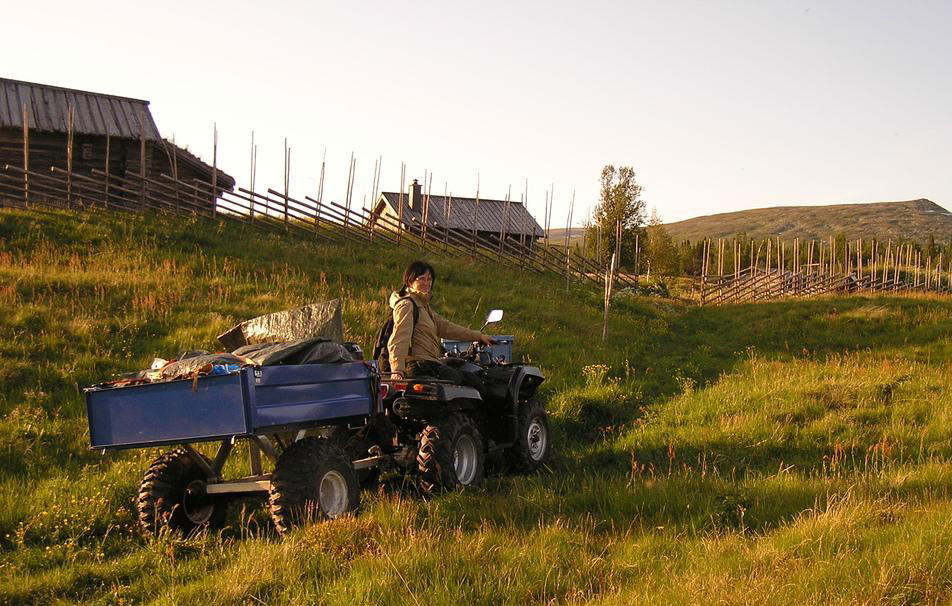Literature
Ekeland, K (ed.) (2008): Landskapets utmarker – hur värdera och sköta? CBM:s skriftserie 22
(How should the landscape’s outlying lands be valued and looked after? CBM’s publication series 22).
Ekeland, K (2014): Mångfaldens utmark (Diversity’s outlying land). Stockholm: Carlsson.
Eriksson, C (2013): Fäboden som politiskt rum: att vara fäbodbrukare i den gemensamma jordbrukspolitiken (The summer farm as a political space: being a summer farmer in the common agricultural policy). Uppsala: The Department of Urban and Rural Development, SLU.
Hansen, K & Jansson, I (1980): Fäbodbruket – hotad näring: rapport om fäbodbruket i Sverige (Summer farming – a threatened industry: report on summer farming in Sweden). Östersund: Jämtland County Administrative Board.
Jacobsson, L, Olofsson C, Stenbäck Lönnquist, U & Welinder, S (2010): Fyra berättelser om arkeologins tysta människor på en fäbod (Four narratives about archaeology’s silent people on a summer farm). I: Rig. 2010:2, pp. [65]–82 : ill.
Karl-Tövåsens fäbod: en levande vall med anor (Karl-Tövåsen’s summer farm: a living pasture with history). (2010) Rättvik: Riesbeck reklam.
Larsson, J (2009): Fäbodväsendet 1550–1920: ett centralt element i Nordsveriges jordbrukssystem (The fäbod phenomenon 1550–1920: a central element in northern Sweden’s agricultural system). Uppsala: The Department of Economics, the Swedish University of Agricultural Sciences.
Lidman, H (ed.) (1963): Fäbodar (Summer farms). Stockholm.
Ljung, T (2011): Fäbodskogen som biologiskt kulturarv: betade boreala skogars innehåll av historisk information och biologisk mångfald: en studie av fyra fäbodställen i Dalarna (The summer farm forest as biological cultural heritage: grazed boreal forests’ content of historical information and biodiversity: a study of four summer farms in Dalarna). The Swedish Biodiversity Centre.
Morén, A (2006): Solsbodarnas fäbod i Gagnefs kommun och församling: ett försök till historisk beskrivning: nedtecknat av Anders Morén vintern 2006 (Solsbodarna’s summer farm in Gagnef Municipality and Parish: an attempt at a historical description: written by Anders Morén, winter 2006). Borlänge.
Nilsson, G (2004): Hanhinvittikko fäbod: flora och vegetation i skuggan av tidigare markanvändning (Hanhinvittikko summer farm: flora and vegetation in the shadow of earlier land use). Report series, 0283-9636 ; 2000:2. Luleå: Norrbotten County Administrative Board.
Olsson, A (1997): Fäbodar i Sverige – underlag för bevarandeplan (Summer farms in Sweden – knowledge base for conservation plan). Jamtli – the regional museum of Jämtland and Härjedalen.
Snell-Lumio, C (1999): Hanhinvittikko: en fäbod i Tornedalen: en fäbods kultur- och miljöhistoria 1878–1965 (Hanhinvittikko: a summer farm in Tornedalen: the cultural and environmental history of a summer farm 1878–1965). Övertorneå naturskyddsförening (Övertorneå Society for Nature Conservation).
Ulfsdotter, J (2009): Fäbodliv i nytt ljus: om ansvarsfördelning och platstagande vid Medelpadska fäbodar vid 1800-talets slut (Summer farm life in a new light: about the distribution of responsibility and taking up space at summer farms in Medelpad at the end of the 19th century). I: Angerman 2009:1, pp. 7–9.
Törnqvist, V (2005): Livet runt en fäbod: Prästbodarna och några andra fäbodar från förr och i modern tid: en dokumentation/sammanställd och skriven av Victoria Törnqvist (Life around a summer farm: Prästbodarna and other summer farms from bygone and modern times: a documentation/compiled and written by Victoria Törnqvist). Rättviks hembygdsförening (Rättvik’s local heritage society).
Åhman, H (2007): Åsn – såmm i minns an: en berättelse från Åsens fäbod i Venjan (Åsen – as we remember it: a story from Åsen’s summer farm in Venjan). Mora.
Öna byalag (1993): Från by och fäbod (From village and summer farm). Mora: Öna byalag (Öna villagers’ association).
Links
Förbundet Svensk Fäbodkultur och utmarksbruk External link. (Association for Swedish summer farming culture and the farming of outlying land– site in swedish).
External link. (Association for Swedish summer farming culture and the farming of outlying land– site in swedish).
Gävleborgs Fäbodförening External link. (Gävleborg’s summer farm association – site in swedish)
External link. (Gävleborg’s summer farm association – site in swedish)
Gävleborgs Fäbodförening (Gävleborg’s summer farm association), 2010. Turister i fäbodvallen. Slutrapport External link. (Tourists at the summer farm. Final report. Via the digital publication platform Yumpu).
External link. (Tourists at the summer farm. Final report. Via the digital publication platform Yumpu).
SLU: “Förstudie om centrum för utmarksbruk” External link. (Preliminary study about a centre for farming on outlying lands) in cooperation with Ljusdalsbygden’s museum, the Swedish Biodiversity Centre (CBM), Gävleborgs Fäbodförening (Gävleborg’s summer farm association) and the University of Gävle.
External link. (Preliminary study about a centre for farming on outlying lands) in cooperation with Ljusdalsbygden’s museum, the Swedish Biodiversity Centre (CBM), Gävleborgs Fäbodförening (Gävleborg’s summer farm association) and the University of Gävle.
Ekeland, K 2006. Perspektiv på säterbruk och fritt skogsbete External link. (Perspectives on summer farming and free forest grazing).
External link. (Perspectives on summer farming and free forest grazing).
Swedish Radio P1: Magnus Nilsson, chef, gave a monologue from Myhrbodarna in Jämtland External link. in the radio station P1’s summer monologue series, (10 August 2015).
External link. in the radio station P1’s summer monologue series, (10 August 2015).
The newspaper Östersundsposten: Fäbod för syns skull? External link. (Summer farm for show?) (31 August 2013).
External link. (Summer farm for show?) (31 August 2013).
The newspaper Östersundsposten: Få aktiva fäbodar finns kvar External link. (Few active summer farms remain) (2 August 2013).
External link. (Few active summer farms remain) (2 August 2013).
Films
Fäbodbruket en kulturell kvarleva – eller ett brukningssätt för framtiden? External link. (Summer farming, a cultural relic – or a farming method for the future?).
External link. (Summer farming, a cultural relic – or a farming method for the future?).
Skogsbete External link. Frida Turander (Forest grazing, a film by Frida Turander).
External link. Frida Turander (Forest grazing, a film by Frida Turander).
Tin Gumuns – Karl Tövåsens fäbod External link. (Tin Gumuns – Karl Tövåsen’s summer farm).
External link. (Tin Gumuns – Karl Tövåsen’s summer farm).

.jpg)
 External link.
External link. External link.
External link. External link.
External link.

.jpg)
